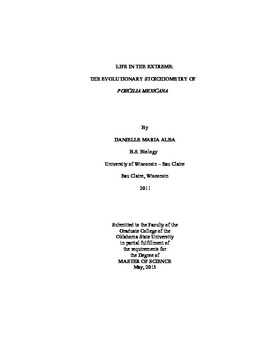| dc.contributor.advisor | Jeyasingh, Punidan D. | |
| dc.contributor.author | Alba, Danielle Maria | |
| dc.date.accessioned | 2016-09-29T18:30:57Z | |
| dc.date.available | 2016-09-29T18:30:57Z | |
| dc.date.issued | 2015-05-01 | |
| dc.identifier.uri | https://hdl.handle.net/11244/45130 | |
| dc.description.abstract | Since The Origin of Species, evolutionary biologists have studied the evolutionary response of organisms to ecological conditions to understand the mechanisms leading biological diversity. The integration of the fields of ecology and evolution is relatively new. The field of ecological stoichiometry is rooted in ecosystem ecology, but the abstraction of evolutionary change as a stoichiometric phenotype enables it as a powerful tool in their integration. The two studies in this thesis are among the first to analyze the ecological consequences of evolutionary change within the stoichiometric framework. I combined the power of the ecological stoichiometry paradigm with a unique system of diverging populations of extremophile fish to test how evolutionary response to ecological conditions has altered the ecological function of these consumers. In my first chapter, I investigated the variation and convergences of the stoichiometric phenotype of Poecilia mexicana. This vigorous assessment included multiple years of field data, across spatially replicated populations, and a common-garden comparison. I found evidence for stoichiometric convergence in derived extremophile populations and variation in their ecological function. In my second chapter, I tested for possible drivers of variation in the stoichiometric phenotype in two populations of P. mexicana. I used amino acids to create diets of excessive sulfur content, mimicking the ecological conditions in which divergent populations have evolved. With these diets, I tested whether derived populations of P. mexicana diverge from ancestral populations in their stoichiometric phenotype. While I found no patterns in nutrient excretion rates, there was evidence for differences between populations in plasticity of elemental demand regardless of dietary conditions. My results clearly show that the stoichiometric phenotypic can be used as a measure of phenotypic change between populations. Furthermore, these results generated several predictions about the ecological consequences of such evolutionary change in the stoichiometric phenotype. Testing such predictions should refine stoichiometric theory in light of evolutionary theory, and thereby further our understanding of the intricate links between ecology and evolution. | |
| dc.format | application/pdf | |
| dc.language | en_US | |
| dc.rights | Copyright is held by the author who has granted the Oklahoma State University Library the non-exclusive right to share this material in its institutional repository. Contact Digital Library Services at lib-dls@okstate.edu or 405-744-9161 for the permission policy on the use, reproduction or distribution of this material. | |
| dc.title | Life in the Extreme: The Evolutionary Stoichiometry of Poecilia Mexicana | |
| dc.type | text | |
| dc.contributor.committeeMember | Baum, Kristen | |
| dc.contributor.committeeMember | Steets, Janette | |
| osu.filename | Alba_okstate_0664M_13921.pdf | |
| osu.accesstype | Open Access | |
| dc.description.department | Zoology | |
| dc.type.genre | Thesis | |
